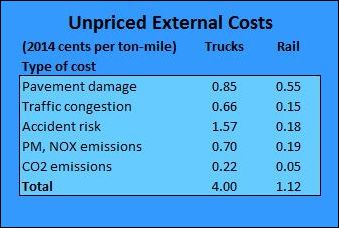
Source: Congressional Budget Office. Instead of publishing a range of costs, I include here an average cost figure for the top four categories. For CO2 emissions, I include CBO’s middle-range estimate.
The “external” costs of transporting goods differ widely by truck and rail, but freight-transport prices do not reflect those costs, argues a new report by the Congressional Budget Office (CBO). In very rough numbers, I calculate from the CBO numbers, the differential amounts to $.03 per ton-mile transported.
That differential is not reflected in the taxes paid by trucking and rail companies. The result is that a far greater share of products are shipped by truck than by rail. Writes David Austin, author of “Pricing Freight Transport to Account for External Costs“:
Adding unpriced external costs to the rates charged by each mode of transport—via a weight-distance tax plus an increase in the tax on diesel fuel—would have caused a 3.6 percent shift of ton-miles from truck to rail and a 0.8 percent reduction in the total amount of tonnage transported. Such a policy would have eliminated 3.2 million highway truck trips per year and saved about 670 million gallons of fuel annually (including the increase in fuel used for rail freight). On net, accounting for the effect of fuel savings on revenue from the fuel tax, such a policy would also have generated about $68 billion per year in new tax revenue and reduced external costs by $2.3 billion.
I don’t know the odds of such a weight-distance tax being implemented on the federal level. I wonder if Virginia could implement it on the state level. One consideration not included here: the cost of administering such a tax.
— JAB


